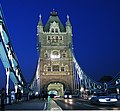Tower Bridge
Coordinates: 51°30′20″N 0°04′32″W / 51.50556°N 0.07556°W
Tower Bridge is a drawbridge in London. It crosses the River Thames near the Tower of London. It allows ships through the bridge deck when is raised at an angle in the centre.
| Characteristics | |
|---|---|
| Design | |
| History | |
| Construction start | 22 April 1886 |
| Construction end | 1894 |
| Location | |
| Script error: The function "auto" does not exist. | |
| Script error: The function "autocaption" does not exist. | |
The north side of the bridge is Tower Hill, and the south side of the bridge comes down into Bermondsey, an area in Southwark. Tower Bridge is far more visible than London Bridge, which people often mistake it for. Many tourists go to London to see the Tower Bridge. It has its own exhibition centre in the horizontal walkway. This gives one of the best vantage points in London.
The "bascules" are the surfaces raised to allow tall ships to pass through: this happens about 900 times per year. The bridge's decks (bascules) can be raised to 83o from the horizontal.
History
The City of London Corporation held a competition for the design in 1876.[1] Over 50 designs were entered, and in 1884 Horace Jones and John Wolfe Barry's design was chosen.
Workers began to build the Tower Bridge in April 1886 and the bridge was opened on 30 June 1894.
In June 2012, the bridge was highlighted on the route of Queen Elizabeth II's Diamond Jubilee Pageant on the Thames.[2]
Design
The bridge is 800 ft (244 m) in length with two towers, each 213 ft (65 m) high, built on piers. The central span of 200 ft (61 m) between the towers is split into two equal bascules or leaves, which can be raised to an angle of 83o to allow river traffic to pass. The bascules, weighing over 1,100 tons each, are counterbalanced to minimize the force required and allow raising in five minutes. The bascules are raised by huge hydraulic pumps which were first powered by steam engines. In 1976 these were replaced by oil and electricity.[1] The bridge is made from more than 11,000 tons of steel, and covered with Cornish granite and Portland stone.[1]
The two side-spans are suspension bridges, each 270 feet (82 m) long, with the suspension rods anchored both at the abutments and through rods contained within the bridge's upper walkways. The pedestrian walkways are 143 feet (44 m) above the river at high tide.[3] These walkways allow people to still cross the river, even when the bridge is raised. They were closed in 1910 because not enough people used them, but were reopened in 1982.[1]
Gallery
Tower Bridge,London Getting Opened
Tower Bridge Photo
Tower Bridge Media
1895 painting of the opening of Tower Bridge, William Lionel Wyllie
Tower Bridge during the first mass air raid on London, 7 September 1940
A Short Sunderland of No. 201 Squadron RAF moored at Tower Bridge during the 1956 commemoration of the Battle of Britain
Tower Bridge with Olympic Rings during the 2012 London Olympics
Related pages
References
- ↑ 1.0 1.1 1.2 1.3 "Tower Bridge Exhibition". towerbridge.org.uk. Retrieved 25 November 2010.
- ↑ Thames Diamond Jubilee Pageant, Key facts Archived 5 June 2012 at the Wayback Machine; Londontown.com, "Thames Jubilee Pageant,". Retrieved 4 June 2012.
- ↑ "Tower Bridge". Archive – the Quarterly Journal for British Industrial and Transport History. Lightmoor Press (3): 47. 1994. ISSN 1352-7991.
Other websites
![]() Media related to Tower Bridge at Wikimedia Commons
Media related to Tower Bridge at Wikimedia Commons
- Tower Bridge Exhibition Archived 27 November 2010 at the Wayback Machine
- Tower Bridge































